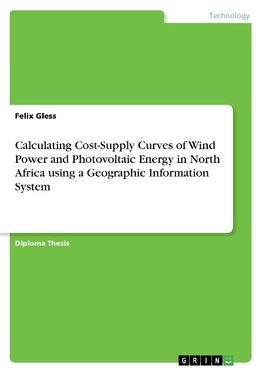
-
 Anglický jazyk
Anglický jazyk
Calculating Cost-Supply Curves of Wind Power and Photovoltaic Energy in North Africa using a Geographic Information System
Autor: Felix Gless
Diploma Thesis from the year 2012 in the subject Engineering - Power Engineering, grade: 1.1, Karlsruhe Institute of Technology (KIT) (Fraunhofer-Institut für System- und Innovationsforschung), language: English, abstract: This thesis aims to assess - from... Viac o knihe
Na objednávku, dodanie 2-4 týždne
49.05 €
bežná cena: 54.50 €
O knihe
Diploma Thesis from the year 2012 in the subject Engineering - Power Engineering, grade: 1.1, Karlsruhe Institute of Technology (KIT) (Fraunhofer-Institut für System- und Innovationsforschung), language: English, abstract: This thesis aims to assess - from an economic and technological perspective - the potentials of wind and PV energy to contribute to the current and future North African and European electricity supply. Available winds and solar irradiation as well as geographic, technological and infrastructure constraints will be included to determine favourable areas for PV and wind energy deployment. How can a power network cope with sizable shares of PV and wind energy? Light will be shed on the broader context of PV and wind energy integration as well.
Considering the targeted energy supply for the North African and European region alike and its designated increase in the share of RES this study aims to answer the question:
How much electrical output is achievable through Photovoltaic and Wind Energy Generation in North Africa today and in the mid- to long-term future, and at what cost?
Thereby the core objective of this diploma thesis is to analyse the North African region, in regard to its economic potential for two renewable energy sources: photovoltaic energy and wind energy. Cost-Supply Curves for the analysed region and the respective energy sources provide Levelised Cost of Electricity (LCOE) in relation to the accumulated available generation potential.
Compared to previous studies, the objective of this analysis is not only to enhance the accuracy of the calculation with up-to-date, better resolution in data inputs as well as higher detail in site selection, but also to broaden the analysis: LCOE and the power generation potential for the years 2030 and 2050 will be estimated. The inclusion of grid infrastructure into the economic assessment shall refine the geographic distribution of potential electrical output. The impact of the North African environment on observed technologies and relevant developments to cope with this impact will gain importance: Concentrated PV - using the highly available direct solar irradiation in Northern Africa - and thin-film technologies will be appraised as well as mono- and polycrystalline PV technologies. The wind energy assessment will include both drive-train concepts - DFIG and EESG.
Finally, it is the goal of this paper to disclose the suitability of PV and wind technologies for a decisive share in energy supply in the North African region as well as possible contributions to the electricity demand of Europe.
- Vydavateľstvo: GRIN Verlag
- Rok vydania: 2017
- Formát: Paperback
- Rozmer: 210 x 148 mm
- Jazyk: Anglický jazyk
- ISBN: 9783668368309











 Nemecký jazyk
Nemecký jazyk